21 Carpet Stains That Are Actually Toxic Mold (Health Alert #14!)
When Sarah discovered black circular spots beneath her living room sofa, she assumed they were simple water stains – until her persistent headaches and unexplained fatigue led to a shocking diagnosis of toxic mold exposure.
You’d be surprised to learn that many common carpet stains aren’t just cosmetic issues but warning signs of dangerous mold growth in your home.
While some discolorations are harmless, others can indicate the presence of harmful species like Stachybotrys chartarum, which poses serious health risks to you and your family.
Before you dismiss those mysterious marks on your carpet, you’ll want to know these critical differences.
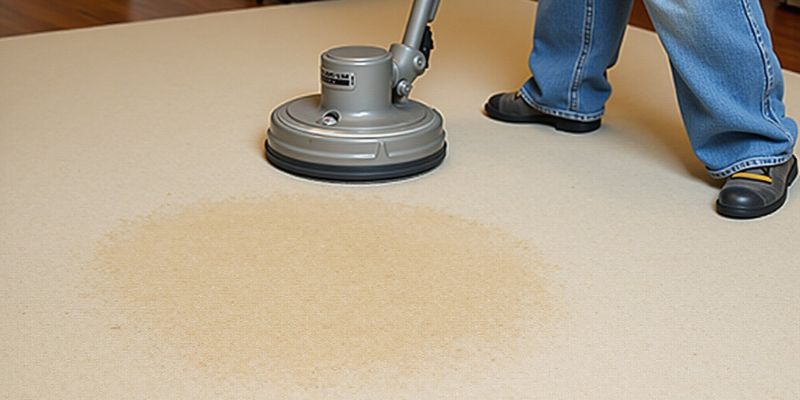
Black Circular Spots
Mold spores often manifest as black circular spots on carpeting when conditions favor fungal growth.
You’ll notice these spots appearing as perfect dark circles ranging from pinhead-size to quarter-size, particularly in areas with moisture exposure or high humidity.
The circular pattern indicates the radial growth characteristic of toxic mold colonies.
Don’t confuse these formations with regular stains – they’ll have distinct, sharp edges and may appear slightly raised or fuzzy.
If you’re seeing multiple spots clustered together, you’re likely dealing with an advanced infestation.
The black coloration typically signals the presence of Stachybotrys chartarum or Aspergillus niger, both known for producing mycotoxins that can compromise your respiratory health.
Testing is essential since visual identification alone can’t confirm toxicity levels.
Greenish-Gray Patches

Unlike the distinct black circles, greenish-gray patches on your carpet signal a different type of toxic mold growth pattern.
These patches typically indicate Cladosporium or Aspergillus species, which thrive in damp environments with poor ventilation.
You’ll notice these patches spread outward in an irregular, blotchy pattern rather than maintaining defined edges.
Don’t let these patches fool you – they’re not simple stains you can scrub away.
The greenish-gray coloration occurs when the mold colonies reach maturity and begin producing spores.
At this stage, they’re actively releasing mycotoxins into your indoor air.
You’ll need to act quickly, as these patches can double in size within 48-72 hours under ideal conditions.
The presence of these patches often indicates a deeper moisture problem that’s compromising your carpet’s backing material.
Rainbow-Like Discoloration
A telltale warning sign of advanced toxic mold infiltration appears as an iridescent, rainbow-like sheen across your carpet’s surface.
This multi-colored discoloration often resembles an oil slick, displaying subtle shifts between blues, purples, and greens when viewed from different angles.
Don’t mistake these prismatic patterns for ordinary stains.
They’re actually indicating that mycotoxin-producing mold species have deeply penetrated your carpet fibers and are actively releasing metabolic compounds.
The rainbow effect occurs when these substances interact with light, creating interference patterns similar to thin-film diffraction.
You’ll typically notice this phenomenon in areas with consistent moisture exposure or high humidity levels.
If you spot these iridescent patches, you’re dealing with a serious contamination that requires immediate professional remediation to protect your health and property.
Dark Basement Corner Marks
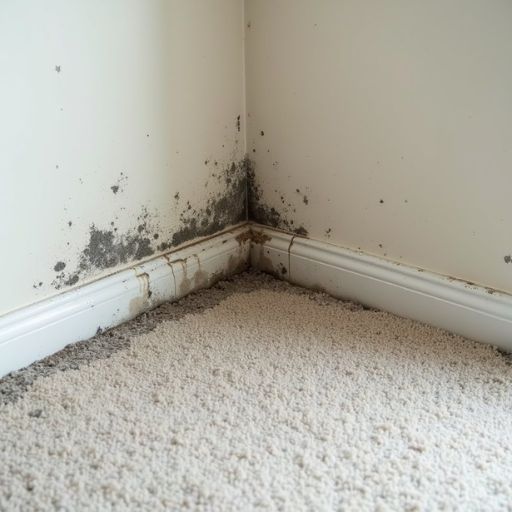
The corners of your basement carpet can reveal sinister evidence of toxic mold growth through distinctive dark, triangular-shaped marks.
These shadowy stains often appear where your carpet meets the baseboards, particularly in areas with poor ventilation and elevated moisture levels.
You’ll notice these marks gradually expand from the corner outward, creating a fan-like pattern that indicates aggressive mold colonization beneath the surface.
Don’t dismiss these corner marks as mere water damage or dirt accumulation.
They’re typically symptoms of Stachybotrys chartarum or Chaetomium growth, both notorious toxic black molds that thrive in damp, dark environments.
If you spot these telltale triangular patterns, you’ll need to act quickly – they’re warning signs that your carpet’s backing has become a breeding ground for potentially dangerous fungal colonies that can compromise your respiratory health.
Musty Brown Rings
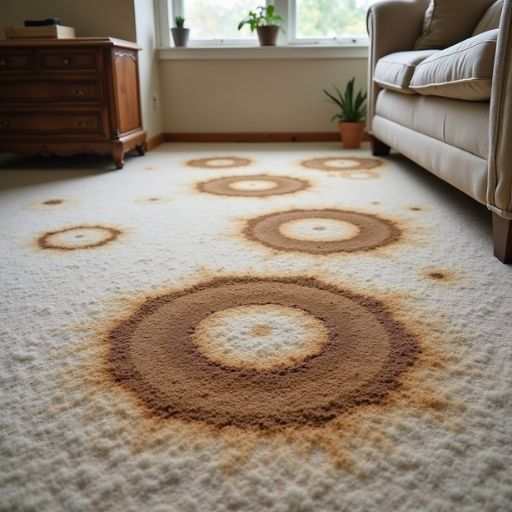
Circular brown stains throughout your carpet often point to extensive mold contamination lurking beneath the surface.
These musty rings typically indicate that moisture has penetrated both the carpet fibers and padding, creating an ideal environment for toxic mold growth.
You’ll notice these rings have a distinctive pattern: darker edges with lighter centers, similar to a coffee stain.
Don’t let their seemingly benign appearance fool you – these formations often signal Stachybotrys chartarum or Chaetomium growth, both known for producing mycotoxins.
When you spot these rings, they’re likely spreading microscopic spores into your indoor air.
Testing is essential if you discover these rings, as conventional cleaning methods won’t address the underlying colonization.
You’ll need to act quickly to protect your respiratory health and prevent cross-contamination to other areas.
Fuzzy White Growth
While brown rings signal advanced mold issues, fuzzy white patches represent early-stage mold colonization in your carpet.
You’ll typically notice these growths in areas with elevated moisture levels, particularly after water damage or in rooms with poor ventilation.
The white, cotton-like appearance indicates actively growing mycelia – the vegetative part of the fungus that’s spreading through your carpet fibers.
Don’t mistake these patches for simple dust or lint.
If you’re seeing fuzzy white growth, you’re witnessing live mold establishing itself in your home’s textiles.
The presence of these colonies means you’ve got 24-48 hours to act before the infestation becomes more difficult to eliminate.
You’ll need to address both the mold and its underlying moisture source to protect your living space.
Raised Carpet Fibers

Over time, toxic mold growth beneath your carpet can cause localized areas of raised or lifted fibers, creating an uneven, bubbled appearance.
When you notice carpet fibers that have risen above the normal surface level, you’re likely witnessing the structural impact of mold growth pushing upward from the padding or subfloor.
You’ll want to examine these raised areas closely – they often form distinct patterns or clusters that differ from normal wear-and-tear lifting.
Run your hand over the affected area; if you feel dampness or notice a musty odor, you’re dealing with active mold growth.
Don’t ignore these warning signs, as they indicate that moisture has penetrated deep into your flooring system.
The lifting typically worsens as the mold colony expands, causing permanent damage to your carpet’s backing and potentially compromising your indoor air quality.
Yellow Stains That Spread
When yellow discoloration appears and gradually expands across your carpet’s surface, you’re likely dealing with an aggressive mold species that’s producing pigmented metabolites.
These yellow-tinted compounds often indicate the presence of Serpula lacrymans or Aspergillus flavus, both known for their ability to rapidly colonize organic materials.
You’ll notice these stains don’t respond to typical carpet cleaning methods and will continue spreading outward in a circular or irregular pattern.
What’s particularly concerning is that these mold species can penetrate deep into carpet fibers and underlying padding, releasing mycotoxins that pose serious health risks.
Don’t attempt to clean these stains yourself – the agitation can release spores into your indoor air.
Instead, seal off the affected area and contact a certified mold remediation specialist who can safely remove the contaminated materials.
Discolored Pet Accident Areas
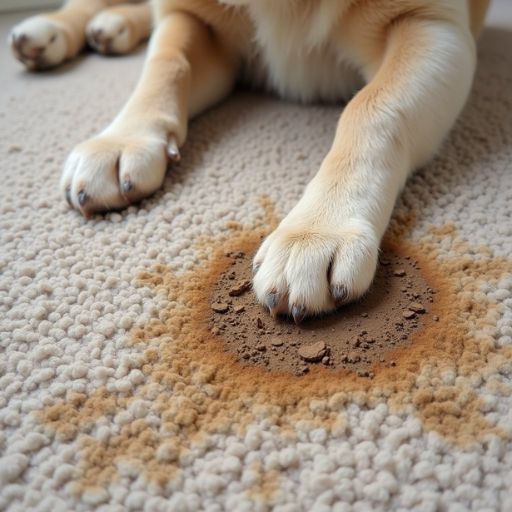
Pet accidents on carpets can create conditions that promote toxic mold growth, particularly if not cleaned properly.
When your pet urinates on carpet, the moisture penetrates deep into the padding and subfloor, creating an ideal environment for various mold species to thrive.
You’ll notice these areas become discolored over time, often appearing as dark rings or patches that don’t match the surrounding carpet.
What you’re seeing isn’t just a stain – it’s potentially toxic mold feeding on organic materials in both the urine and carpet fibers.
The discoloration typically worsens in humid conditions, and you may detect a musty odor that’s distinct from the original pet accident smell.
Don’t mistake these spots for simple stains – they require professional remediation to prevent harmful spore circulation throughout your home.
Damp Window Carpet Marks
Consistently appearing near windows, dark carpet stains indicate serious moisture problems that can harbor toxic mold growth.
You’ll notice these marks forming when condensation drips from windows or when rain seeps through faulty seals, creating ideal conditions for hazardous mold species like Stachybotrys chartarum.
Don’t ignore these window-adjacent stains, as they’re often accompanied by a musty odor and can spread toxic spores throughout your home.
The moisture damage extends beyond surface discoloration – it’s penetrating your carpet padding and subfloor.
You’ll need to address both the water intrusion source and remove affected materials.
Check your window seals, install dehumidifiers, and consider upgrading to double-pane windows.
If the stains persist or cover areas larger than 10 square feet, contact a certified mold remediation specialist immediately.
Purple-Tinted Spots
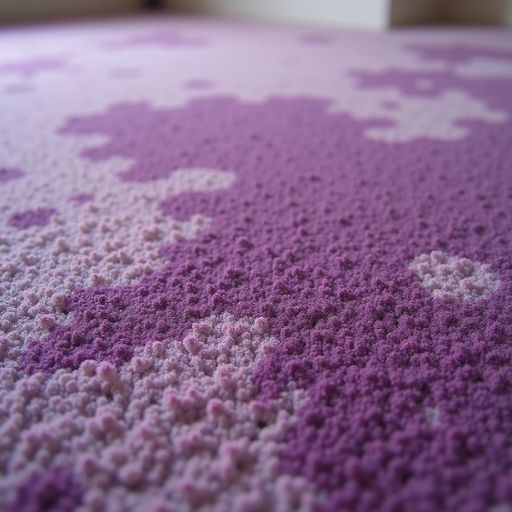
Strange purple-tinted spots appearing on your carpet often signal the presence of Chaetomium mold, a particularly concerning fungi species that thrives in chronically damp conditions.
You’ll notice these spots developing a distinct purplish hue, especially in areas where water damage has occurred or humidity levels remain consistently high.
Don’t mistake these discolorations for regular stains – they’re living organisms that can release mycotoxins into your indoor air.
When you spot purple-tinted areas, especially if they’re accompanied by a musty odor, you’re likely dealing with an active mold colony that’s already penetrated deep into the carpet fibers.
You must act quickly to protect your health: isolate the affected area, guarantee proper ventilation, and consider replacing the contaminated carpet sections rather than attempting remediation.
Expanding Dark Patches
Dark patches spreading across your carpet represent one of the most alarming indicators of aggressive mold growth, typically caused by species like Stachybotrys chartarum or Aspergillus niger.
You’ll notice these patches expand outward in irregular patterns, often growing several inches per week in humid conditions.
If you spot expanding dark areas that don’t respond to regular cleaning, you’re likely dealing with a serious mold infestation that’s penetrating deep into your carpet fibers.
Don’t ignore these patches – they’ll continue to spread and can release harmful mycotoxins into your indoor air.
The expanding pattern indicates that the mold has established a strong colony and is actively searching for new food sources.
You’ll need to take immediate action, as these aggressive mold species can compromise your respiratory health and structural integrity.
Rust-Colored Circles

When toxic mold infiltrates carpet fibers, it often manifests as distinct rust-colored circles ranging from 2-6 inches in diameter.
These circular formations typically indicate Stachybotrys chartarum or Aspergillus niger colonies that have established themselves deep within your carpet’s pile.
You’ll notice these rust-colored rings have a darker center with lighter edges, creating a target-like pattern.
Don’t mistake these formations for simple water stains or spills.
If you’re seeing multiple rust-colored circles, especially in areas prone to moisture, you’re likely dealing with a serious mold infestation.
The rust coloration comes from the mold’s metabolic processes as it breaks down carpet fibers and releases pigmented compounds.
You’ll need to act quickly, as these circles indicate the mold has already penetrated beyond the carpet’s surface.
Water Damage Lines
Beyond the circular formations, water damage lines present another distinct indicator of toxic mold growth in carpets.
You’ll notice these telltale lines appearing as elongated, darker streaks that follow water’s natural flow pattern across your flooring.
They’re often accompanied by a musty odor and slight discoloration of the carpet fibers.
When you spot these linear patterns, particularly near walls, windows, or under furniture, you’re likely dealing with sustained moisture exposure that’s created an ideal environment for toxic mold species.
These lines typically indicate where water has repeatedly seeped into your carpet’s backing and pad.
Don’t ignore them – they’re warning signs of potential health hazards.
The presence of these water damage lines means you’ll need to act quickly to prevent the spread of harmful mold spores throughout your living space.
Orange Carpet Spots
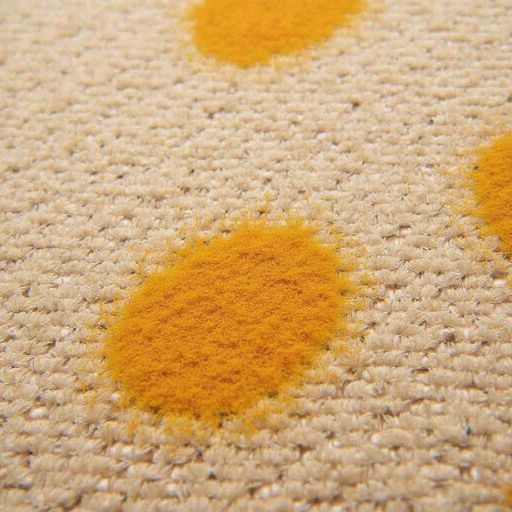
Orange spots appearing on your carpet represent one of the most concerning signs of toxic mold infestation.
When you notice rust-colored or orange-tinted patches emerging on your carpet fibers, you’re likely dealing with Serpula lacrymans or similar destructive fungi that thrive in damp conditions.
Don’t mistake these orange discolorations for simple stains – they’re often indicators of aggressive dry rot that’s actively destroying your carpet’s backing and potentially the subfloor beneath.
You’ll typically find these spots in areas with moisture issues or previous water damage.
The orange pigmentation comes from the mold’s spores and metabolic processes, particularly their interaction with cellulose materials.
Take immediate action if you spot these distinctive markings, as they signal a potentially hazardous mold situation that requires professional remediation.
Blackened Air Vent Stains
Dark stains radiating from air vents onto your carpet present a critical warning sign of toxic mold colonization within your HVAC system.
When you spot blackened areas spreading outward from floor vents, you’re likely witnessing the dispersal of Stachybotrys chartarum or Aspergillus niger spores through your home’s air circulation.
Don’t mistake these marks for ordinary dust accumulation.
The characteristic black or deep green-black stains indicate that mold colonies have established themselves in your ductwork, continuously releasing spores that settle onto your carpet fibers.
You’ll need to act swiftly – these patches won’t respond to standard carpet cleaning methods.
Contact an HVAC specialist immediately to inspect your system’s components and schedule professional remediation.
Your freedom to breathe safely in your own home depends on addressing this contamination promptly.
Reddish-Brown Spots Near Walls
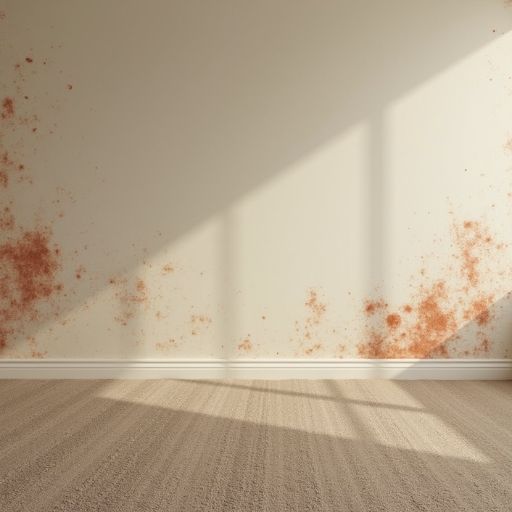
Reddish-brown discoloration appearing near baseboards and wall edges often signals the presence of Chaetomium globosum, a particularly aggressive toxic mold species that thrives in moisture-damaged building materials.
You’ll typically notice these stains developing in areas where your walls meet carpeting, especially if there’s been water damage or high humidity.
Don’t mistake these marks for simple dirt or wear patterns.
Chaetomium globosum produces mycotoxins that can trigger severe respiratory issues, neurological symptoms, and immune system responses.
If you spot these characteristic stains, you’ll need to act quickly – they indicate the mold has already penetrated deep into your carpet padding and potentially the subfloor.
Testing is essential, as this species can spread rapidly through your home’s structure while remaining largely hidden from view.
Carpet Edge Discoloration
Along carpet edges and doorways, persistent discoloration that’s resistant to cleaning often indicates the presence of Stachybotrys chartarum or other toxic mold species.
You’ll notice these dark bands forming gradually, particularly where your carpet meets baseboards or shifts to other flooring materials.
When you spot discoloration in these areas, don’t assume it’s just normal wear or dirt accumulation.
What you’re likely seeing is moisture-loving mold feeding on carpet fibers and backing materials.
The darkening occurs as mold colonies expand beneath the visible surface, often spreading several inches beyond the visible stain.
You’ll need to lift the carpet’s edge to confirm – if you see black, green, or grayish growth on the backing, you’re dealing with toxic mold that requires immediate professional remediation.
Furniture Shadow Marks
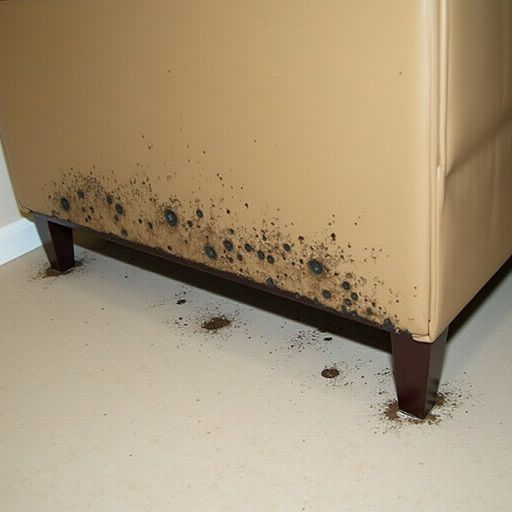
When you notice persistent stains beneath furniture that remain after moving pieces, you’re likely seeing toxic mold growth triggered by trapped moisture.
These shadow marks aren’t mere dust outlines – they’re potentially dangerous colonies of mold that thrive in the dark, humid microenvironment created by your furniture placement.
You’ll typically find these marks under heavy items like sofas, cabinets, and bookcases that restrict airflow.
The problem intensifies if you’ve got high indoor humidity levels or your carpet sits on a concrete slab.
Don’t ignore these marks – they’re often indicators of Stachybotrys chartarum or Chaetomium, two particularly toxic mold species.
You’ll need to act quickly by removing the furniture, drying the area thoroughly, and testing for active mold growth to protect your health.
Bathroom Door Threshold Stains
Bathrooms create prime conditions for toxic mold growth, and you’ll often spot the first signs at your door’s threshold.
The combination of high humidity, temperature fluctuations, and water splashing creates an ideal environment for mold colonization where your bathroom carpet meets the threshold.
You’ll notice dark, irregular stains that don’t respond to regular cleaning.
These patches often appear grayish-black or greenish and may have a subtle fuzzy texture.
They’re particularly concerning because the visible staining typically indicates extensive underlying growth beneath your carpet padding.
Don’t ignore these threshold stains – they’re warning signs of a serious moisture control issue.
The mold spores can migrate into your living space through the gap under your door, potentially triggering respiratory issues and other health complications.
Windowsill Carpet Shadows

Dark patches beneath windowsills often indicate toxic mold growth in your carpet, typically caused by condensation and water infiltration around window frames.
You’ll notice these shadows forming gradually as moisture seeps into your carpet fibers, creating an ideal environment for dangerous mold species like Stachybotrys chartarum and Aspergillus niger.
Don’t ignore these warning signs – they’re clear indicators that you’ve got both a moisture control issue and a potential health hazard.
You’ll need to address the root cause by sealing window leaks, improving ventilation, and maintaining proper indoor humidity levels below 60%.
Cut out and replace affected carpet sections immediately, as toxic mold can release dangerous mycotoxins into your indoor air.
Consider installing moisture barriers or switching to hard flooring near windows to prevent future mold colonization.
FAQs
Can Mold Growth in Carpets Affect Property Value During Resale?
Yes, you’ll find that mold growth in carpets can markedly decrease your property’s resale value, as it signals potential structural issues and health hazards. Buyers often demand substantial price reductions or avoid affected properties entirely.
How Often Should Professional Mold Testing Be Done in Carpeted Rooms?
With 50% of homes having hidden mold, you’ll want to test carpeted rooms annually. If you’re in humid climates or notice musty odors, schedule inspections every 6 months for ideal protection and peace of mind.
Are Air Purifiers Effective in Preventing Toxic Mold Growth in Carpets?
While air purifiers can help reduce airborne mold spores, they won’t prevent carpet mold growth. You’ll need to control moisture levels, maintain proper ventilation, and keep your carpet dry for effective mold prevention.
What Temperature Settings Help Minimize Mold Growth in Carpeted Spaces?
Studies show mold grows 70% slower below 60°F. You’ll want to maintain your room temperature between 68-72°F, with humidity below 60%. Keep your AC running consistently to prevent moisture accumulation in carpeted areas.
Do Carpet Warranties Typically Cover Damage From Toxic Mold Infestations?
Most carpet warranties don’t cover mold damage, as it’s considered preventable through proper maintenance. You’ll need to check your specific warranty terms, but manufacturers typically exclude damage from moisture-related issues and environmental factors.
Final Thoughts
You’ll need to act swiftly when identifying these carpet stains, as they’re often indicators of toxic mold presence.
By monitoring circular spots, tracking discoloration patterns, and examining threshold marks, you’re safeguarding your indoor environment.
Don’t dismiss these warning signs: document the affected areas, contact certified mold remediation specialists, and implement moisture control measures.
Your health depends on prompt, thorough intervention against these potentially hazardous conditions.